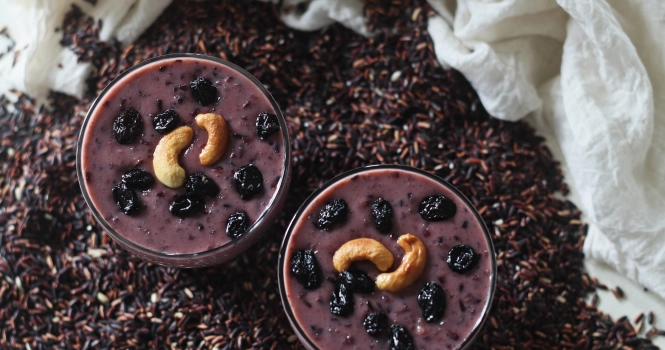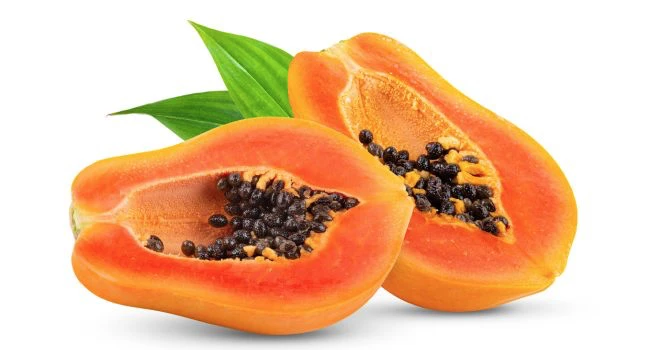Discover the Nutritional Delight of Black Rice Kheer

Kheer, a traditional Indian dessert known for its creamy texture and delicate flavors, finds a nutritious and exotic twist with black rice.
Black rice kheer combines the health benefits of black rice with the comforting sweetness of classic kheer, making it a unique and wholesome treat.
Let’s look into the delightful world of black rice kheer, exploring its nutritional value, preparation, and the cultural fusion it represents.
What is Black Rice?
Black rice, often referred to as “forbidden rice,” is a highly nutritious and ancient grain that has been cultivated for centuries in Asia, particularly in China and India. It is known for its striking dark purple, almost black color when raw, which turns deep purple when cooked. This unique coloration is due to the presence of anthocyanins, the same type of antioxidants found in dark berries like blueberries and blackberries.
Black rice is rich in nutrients, offering higher levels of protein, fiber, and antioxidants compared to white or brown rice. It is also a good source of several minerals, including iron and zinc. The high antioxidant content, particularly anthocyanin, contributes to various health benefits, such as anti-inflammatory properties, heart health support, and potential anti-cancer effects.
Historically, black rice was reserved for the Chinese nobility due to its rarity and perceived health benefits, which is how it earned the name “forbidden rice.”
Today, it is available worldwide and is used in a variety of dishes, from traditional Asian desserts and porridges to contemporary salads, sushi, and bowls, appreciated for its nutty flavor, chewy texture, and nutritional value.
Nutritional Benefits
The health benefits of black rice are extensive. It is high in antioxidants, which help combat free radicals and reduce inflammation. The fiber content promotes digestive health, while its low glycemic index makes it suitable for those monitoring their blood sugar levels.
Incorporating black rice into kheer not only enhances the dessert’s nutritional profile but also introduces an intriguing color and nutty flavor.
How to make Black Rice Kheer?
Making Black Rice Kheer is a delightful way to enjoy this nutritious grain in a sweet and creamy dessert. Here’s a simple and tasty recipe for you to try:
Ingredients:
- 1 cup black rice
- 4 cups full-fat milk (you can also use coconut milk for a vegan version)
- 1/2 to 3/4 cup sugar or jaggery (adjust to taste)
- 1/2 teaspoon cardamom powder
- A pinch of saffron (optional)
- 2 tablespoons ghee (clarified butter) or coconut oil for a vegan option
- A handful of mixed nuts (almonds, cashews, pistachios) and raisins
- A few strands of saffron for garnishing (optional)
Instructions:
1. Preparation: Rinse the black rice thoroughly under running water until the water runs clear. Soak the rice in water for at least 6-8 hours or overnight to reduce cooking time and make it easier to digest.
2. Cook the Rice: Drain the soaked rice and add it to a heavy-bottomed pan. Pour in the milk and bring the mixture to a boil. Once boiling, reduce the heat to low, allowing the rice and milk to simmer gently. Stir occasionally to prevent sticking and ensure even cooking.
3. Add Flavor: As the rice begins to soften and the mixture thickens, add the sugar or jaggery and cardamom powder. If using, also add the saffron for an extra layer of flavor and color. Continue to cook on low heat, stirring regularly, until the kheer reaches a creamy consistency.
4. Fry the Nuts and Raisins: In a small pan, heat the ghee or coconut oil over medium heat. Add the mixed nuts and raisins and fry them until they turn golden brown. Be careful not to burn them.
5. Combine: Add the fried nuts and raisins to the kheer, reserving some for garnishing. Mix well to ensure they are evenly distributed throughout the kheer.
6. Garnish and Serve: Once the kheer is cooked to your desired consistency, remove it from the heat. Garnish with the reserved nuts, raisins, and saffron strands. Serve the kheer warm or chilled, according to your preference.
This Black Rice Kheer is not just a treat to the taste buds but also packs a nutritional punch, making it a guilt-free indulgence. Enjoy the unique flavors and health benefits of black rice in this traditional yet exotic dessert.
Cultural Significance
Kheer is a beloved dessert across India, enjoyed during festivals, celebrations, and as a comforting treat. The use of black rice in kheer is a beautiful blend of traditional Indian cooking with the distinctive qualities of this ancient grain, showcasing culinary innovation while respecting heritage.
Why Try Black Rice Kheer?
Black rice kheer is not just a dessert; it’s an experience. Its striking appearance, coupled with its creamy texture and complex flavors, makes it a delightful end to any meal. For those looking to experiment with traditional recipes or seeking healthier dessert alternatives, black rice kheer is an excellent choice.
Black rice kheer is a testament to the versatility and adaptability of traditional cuisines to incorporate healthier ingredients without compromising on taste.
This dessert offers a way to enjoy the richness of kheer while benefiting from the nutritional advantages of black rice. Whether you’re a culinary enthusiast or simply looking for a healthier dessert option, black rice kheer is worth exploring.
Frequently Asked Questions
Which rice is good for kheer?
For making kheer, short-grain rice varieties are typically preferred due to their creamy texture and ability to absorb flavors well.
Traditional choices include Basmati rice for its fragrant aroma and delicate texture, and short-grain white rice varieties like Sona Masoori or Govind Bhog, which become soft and creamy upon cooking, making them ideal for the pudding-like consistency of kheer.
Recently, healthier alternatives like black rice and brown rice are also being used to add a nutritional twist to the traditional kheer, offering a unique flavor and texture profile.
Why is black rice so expensive?
Black rice is often more expensive than common white or brown rice varieties for several reasons:
Lower Yield: Black rice varieties generally have a lower yield per hectare compared to more common rice types, contributing to higher production costs.
Cultivation Requirements: Black rice requires specific growing conditions and careful cultivation, which can be more labor-intensive.
Harvesting and Processing: The harvesting and processing of black rice can be more challenging due to its unique hull. The process of milling black rice to retain its nutritional outer layer while making it edible also adds to the cost.
Nutritional Value: Black rice is prized for its high antioxidant content, particularly anthocyanin, which gives it its distinctive color and numerous health benefits. This nutritional profile can make it more desirable and, consequently, more expensive.
Market Demand: As a specialty grain with growing popularity in health-conscious and gourmet circles, the demand for black rice can outstrip supply, leading to higher prices.
Overall, while black rice may be more costly, its unique flavor, nutritional benefits, and visual appeal can make it a worthwhile addition to a variety of dishes, including the exotic black rice kheer.












